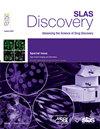Discovery and validation of small molecule stabilizers of mutant triose phosphate isomerase (TPI) as potential lead candidates for TPI deficiency
IF 2.7
4区 生物学
Q2 BIOCHEMICAL RESEARCH METHODS
引用次数: 0
Abstract
Triosephosphate Isomerase deficiency (TPI-Df) is a devastating untreatable childhood metabolic disease resulting in anemia, severe locomotor impairment, and premature death. Numerous single amino acid substitutions in TPI are pathogenic and result in rapidly progressing multisystem disease. Importantly, all known pathogenic TPI-Df mutations result in a protein that retains function, and pathogenesis is known to result from decreased steady state levels of the functioning protein. There are no small molecule therapies for TPI-Df; current treatments are limited to symptomatic support and dietary interventions. We reasoned that a phenotypic screen was most appropriate to capture agents that stabilize mutant TPI and developed a human cellular TPI-Df assay based on a cellular model of the “common” TPIE105D mutant protein fused with a GFP and a fluorescent ROS biosensor. The assay was implemented for high-content, high-throughput imaging, optimized to full HTS standards, and used to screen a 2,560 compound pilot library and the 220,700 compound NIH MLSMR compound collection to identify candidate compounds for development into small molecule TPI-Df therapies. Hits were validated in dose-response, TPI-Df patient cells, and various orthogonal assays. Limited SAR revealed three promising compound series, which were evaluated for potential mechanisms of action. The lead series had previously been identified as inducers of HIF1 alpha, spawning a novel hypothesis that HIF1 alpha activation might be a potential avenue to treat TPI-Df patients. A lead molecule was moved into preliminary mouse studies to evaluate pharmacokinetics and tissue distribution and was shown to be moderately brain-penetrant. The lead compound is now positioned for target identification studies and efficacy testing in vivo TPI Df models, including a newly validated mouse model.
突变型磷酸三糖异构酶(TPI)的小分子稳定剂的发现和验证作为TPI缺陷的潜在候选物。
三磷酸异构酶缺乏症(TPI-Df)是一种毁灭性的无法治愈的儿童代谢性疾病,可导致贫血、严重运动障碍和过早死亡。TPI中的许多单氨基酸取代是致病性的,并导致快速进展的多系统疾病。重要的是,所有已知的致病性TPI-Df突变都会导致一种保留功能的蛋白质,而已知的发病机制是由于功能蛋白的稳态水平下降。目前还没有针对TPI-Df的小分子疗法;目前的治疗仅限于症状支持和饮食干预。我们认为表型筛选最适合捕获稳定突变TPI的药物,并基于“常见”TPIE105D突变蛋白与GFP和荧光ROS生物传感器融合的细胞模型开发了人类细胞TPI- df测定。该方法实现了高含量、高通量成像,优化到完全符合HTS标准,并用于筛选2,560个化合物先导文库和220,700个化合物NIH MLSMR化合物集合,以确定用于开发小分子TPI-Df疗法的候选化合物。hit在剂量-反应、TPI-Df患者细胞和各种正交试验中得到验证。有限的SAR揭示了三个有前途的化合物系列,并对其潜在的作用机制进行了评估。导联系列先前已被确定为HIF1 α的诱导剂,这产生了一个新的假设,即HIF1 α激活可能是治疗TPI-Df患者的潜在途径。一种铅分子被转移到初步的小鼠研究中,以评估药代动力学和组织分布,并显示出适度的脑渗透。目前,该先导化合物已被用于TPI Df模型(包括一种新验证的小鼠模型)的靶点识别研究和有效性测试。
本文章由计算机程序翻译,如有差异,请以英文原文为准。
求助全文
约1分钟内获得全文
求助全文
来源期刊

SLAS Discovery
Chemistry-Analytical Chemistry
CiteScore
7.00
自引率
3.20%
发文量
58
审稿时长
39 days
期刊介绍:
Advancing Life Sciences R&D: SLAS Discovery reports how scientists develop and utilize novel technologies and/or approaches to provide and characterize chemical and biological tools to understand and treat human disease.
SLAS Discovery is a peer-reviewed journal that publishes scientific reports that enable and improve target validation, evaluate current drug discovery technologies, provide novel research tools, and incorporate research approaches that enhance depth of knowledge and drug discovery success.
SLAS Discovery emphasizes scientific and technical advances in target identification/validation (including chemical probes, RNA silencing, gene editing technologies); biomarker discovery; assay development; virtual, medium- or high-throughput screening (biochemical and biological, biophysical, phenotypic, toxicological, ADME); lead generation/optimization; chemical biology; and informatics (data analysis, image analysis, statistics, bio- and chemo-informatics). Review articles on target biology, new paradigms in drug discovery and advances in drug discovery technologies.
SLAS Discovery is of particular interest to those involved in analytical chemistry, applied microbiology, automation, biochemistry, bioengineering, biomedical optics, biotechnology, bioinformatics, cell biology, DNA science and technology, genetics, information technology, medicinal chemistry, molecular biology, natural products chemistry, organic chemistry, pharmacology, spectroscopy, and toxicology.
SLAS Discovery is a member of the Committee on Publication Ethics (COPE) and was published previously (1996-2016) as the Journal of Biomolecular Screening (JBS).
 求助内容:
求助内容: 应助结果提醒方式:
应助结果提醒方式:


